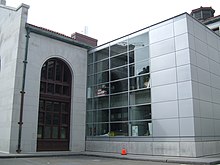Shot peening
The shot peening or shot peening is a field of application of the blasting in accordance with DIN 8200. The usual fields of application are the surface finishing rays beam machining, cleaning and the Umformstrahlen. The name shot peening can be traced back to the use of spherical blasting media .
Shot peening is a surface treatment . Small abrasive grains are thrown at high speed against the surface to be treated (blasting material) by means of blasting wheels, compressed air or injector blasting systems. Due to the high speed and the high air pressure (up to approx. 10 bar, normally 2–7 bar) in the line, the abrasive is accelerated and made to impact the surface to be processed (abrasive). This artificially introduces defects (flaws) into the atomic lattice, which, as in autofrettage, lead to a local compression of the material and thus cause internal compressive stresses . (It is shot peened on the tensile side of a workpiece in order to generate internal compressive stresses, which in turn counteract the tensile stresses).
In shot peening, the aspect of introducing residual compressive stresses in order to increase the fatigue strength of the material comes to the fore. It is scientifically proven that cracks, e.g. B. by corrosion fatigue, never arise in a layer with residual compressive stress. The increased corrosion resistance and the enlargement of the surface, the z. B. plays an important role when bonding components, are two reasons that contribute to the widespread use of blasting.
A major disadvantage of this method is that incorrect process management (e.g. too high pressure, too little distance from the blasting material) can weaken the component. One possible consequence of this is a truncated and / or reduced fatigue strength and bending strength of the workpiece. In order to counteract this, since the development of the procedure (approx. 1935) various test mechanisms such as B. Almenintensity , coverage control or Peenscan (a luminous color that becomes visible under ultraviolet light) introduced, which have proven themselves when used properly.
Shot peening has long been used in the aviation industry for engine components, but is now also finding its way into other industries, such as B. in engine or gear manufacturing.
Laser peening and high-frequency hammering were developed as a further development of shot peening . With the help of a water film as a pressure wave transmitter, particularly low internal compressive stresses are induced in order to increase the component service life. In 2014 Starrag implemented a high-frequency hammering process (“ peening ”) in machining centers for turbine machining , which fulfills the tasks of shot peening and thus replaces it.
The shot peening process is also used in the renovation of floors and in the coating area: In order to remove poorly strong layers (cement slurry or old paintwork) and thereby achieve the required tensile strength of> 1.5 N, the floor surface is shot peened with blasting machines that work with dust extraction at the same time .
Safe process control is important for shot peening in order to maintain the positive properties of the residual compressive stresses and reproducible qualities. When measuring the intensity of the alpine pastures , the currently common method for controlling the blasting process, a small plate made of hardened steel - the so-called mountain pasture plate - is bombarded with the abrasive. Conclusions about the blasting process can be drawn from the curvature of the plate. The problem here is that the actual blasting process has to be interrupted for this measurement. In a newer method, which was developed by the Aachen peening center, the speed of the blasting agent is measured by means of a double light barrier in front of the blasting nozzle.
See also
Individual evidence
- ↑ Machine tools : hammering at high speed. Retrieved December 4, 2015 .
